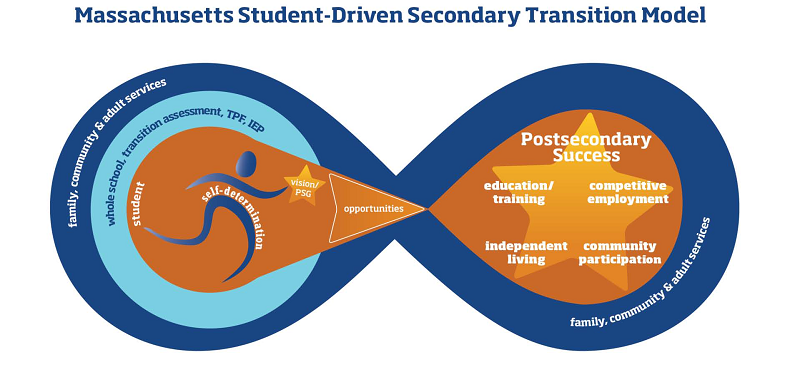Secondary Transition
Join the Secondary Transition Forum!JOIN US in a new online forum on Secondary Transition. This forum features discussion and resources, and is designed to encourage the flow of Transition-related information among all interested parties in Massachusetts: students, families, school professionals, employers, adult agencies, higher education, etc., in order to improve postsecondary outcomes for students with disabilities. About Secondary Transition:For Massachusetts students receiving special education services, "secondary transition" is a time that begins when they turn 14 (or earlier, if the IEP team agrees). From age 14 until they graduate or turn 22, students with IEPs receive "transition services" from their public school districts. Transition services are defined by federal law (the Individuals with Disabilities Education Act, or IDEA) as a "coordinated set of activities...designed to be within a results oriented process...to facilitate the student's movement from school to post-school activities." Transition services are based on the individual student's needs, taking into account his/her strengths, preferences, and interests. These are school services which will help ensure that young adults will live, work, and/or go to postsecondary school as independently as possible when they leave public school. The Massachusetts Student-Driven Secondary Transition Model: The Massachusetts Student-Driven Secondary Transition Model visually represents this movement from school to post-school life. It emphasizes the central, most important characteristic of a successful secondary transition process: it is student-driven. Successful students understand their own strengths and limitations, know themselves to be "causal agents in their own lives," have a vision for the future, and are directly involved in actualizing that vision. Throughout the course of their lives, in school and beyond, individuals with disabilities are supported by family, community, and (in some cases) state agencies. In this visual model, the dark blue infinity symbol denotes the lifelong interdependence of every person, who from school days (on the left) progresses to adult life (on the right). This model can be used as a reference to inform the planning and delivery of secondary transition programs and services, on an individual and system-wide basis.On the left side of the model is the student with disabilities in the school environment. Fully self-determined, the student acquires and internalizes self knowledge and key skills, including the ability to evaluate options, make choices and decisions, self regulate, self advocate, set and attain goals, solve interpersonal problems, communicate competently, and effect change according to one's preferences. The gold star in the student's outstretched hand guides the entire secondary transition process. This star is the student's vision, expressed as postsecondary goals (PSG) which ultimately are realized in adult postsecondary success, as shown on the right side of the model. The center of the model In the center of the model, the arrowhead pointing to postsecondary success represents the individualized opportunities in the areas of education/training, competitive employment, independent living, and community participation that the student experiences during the transition years. These opportunities - both on the school campus and in community locations - are facilitated by those on the left side of the visual model: the student him- or herself; the whole school, including special education; family; community; and adult services. All IEP team members share responsibility for planning these essential experiences, through which the student builds the knowledge and skills he or she needs in order to achieve his or her postsecondary vision/PSG. On the right side of the model is the adult with disabilities, beyond secondary school. On the right side of the model, the student's vision/PSG is actualized. No longer in secondary school, the student has achieved his or her postsecondary goals - the gold star - in the domains of education/training, competitive employment, independent living, and community participation. For more information, see http://www.doe.mass.edu/sped/2013/SecondaryTransition/VisualModel.pdf . How can you learn more about secondary transition, share ideas, and explore resources? Visit the Secondary Transition Forum! |
